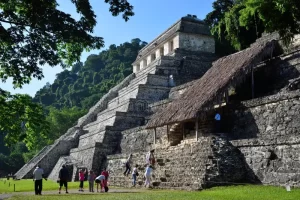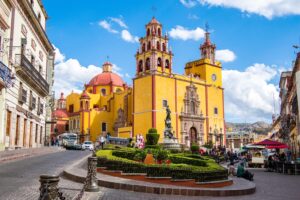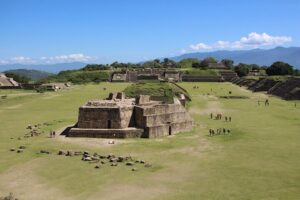
Mexico, a country steeped in history and vibrant culture, offers tourists a wealth of historical sites that tell the story of its rich and diverse past.
From the majestic pyramids of ancient civilizations to the colonial architecture of its charming towns, Mexico’s historical landmarks provide a fascinating glimpse into the country’s evolution over the centuries.
This article invites you on a journey through time, highlighting the top 10 must-visit historical sites that capture the essence of Mexico’s heritage.
Whether you’re an avid history buff or simply looking to enrich your travel experience, these iconic destinations promise to leave you awe-inspired and deeply connected to the spirit of Mexico.
Join us as we explore the architectural marvels, archaeological wonders, and cultural gems that make Mexico a top destination for history enthusiasts and curious travelers alike.
1. Chichen Itza:
2. Teotihuacan:
3. Palenque:
4. Tulum:
5. Guanajuato:
6. Oaxaca City:
7. Monte Alban:
8. Puebla:
9. Copper Canyon:
10. Templo Mayor:
1. Chichen Itza in Mexico:

In the heart of Mexico’s Yucatán Peninsula, where the pulse of ancient times still echoes, lies Chichen Itza—one of the New Seven Wonders of the World.
This sacred city, a UNESCO World Heritage Site, invites travelers to step into the past and witness the grandeur of a civilization that once thrived here.
At the heart of this ancient world stands El Castillo, the Temple of Kukulkan—an awe-inspiring pyramid that reaches for the heavens.
During the equinoxes, the sun’s rays dance across its stairs, casting a shadow that resembles a serpent descending to the earth, a tribute to the Mayans’ deep understanding of the cosmos.
Beyond the pyramid, the Great Ball Court unfolds, its acoustics so perfect that a clap at one end can be heard at the other.
Here, the Mayans played the ancient game of Pok-a-Tok, a ritual of life and death.
Nearby, the Temple of the Warriors and the Thousand Columns stand as testaments to Mayan artistry; moreover, their intricate carvings vividly tell stories of power and faith
The Caracol Observatory, a circular structure used to study the stars, reveals the Mayans’ mastery of astronomy.
Indeed, Chichen Itza is not merely a site of ruins—it’s a journey into the soul of the Mayan people, where history, culture, and mystery, furthermore, weave together in one unforgettable experience.
2. Teotihuacan in Mexico:

Nestled just 50 kilometers northeast of Mexico City, Teotihuacan—the “City of the Gods”—rises from the earth like a dream carved in stone.
Flourishing between the 1st and 7th centuries, this ancient Mesoamerican city now stands as a UNESCO World Heritage Site, drawing visitors from every corner of the globe to walk in the footsteps of a lost civilization.
At the heart of Teotihuacan, likewise, stand its towering pyramids: the Pyramid of the Sun and the Pyramid of the Moon.
Indeed, the mighty Pyramid of the Sun, one of the largest in the world, beckons travelers.
From here, the horizon stretches endlessly, a testament to the empire’s once-great power.
The smaller Pyramid of the Moon, at the northern end of the Avenue of the Dead, offers a different perspective—an intimate view of the ruins that feels both ancient and alive.
Walking along the Avenue of the Dead, visitors encounter the Temple of the Feathered Serpent, where intricate carvings of serpents breathe life into the stone.
The Ciudadela, with its vast square, and the Palace of the Jaguars, alive with colorful murals, whisper secrets of daily life, religion, and artistry.
Teotihuacan is more than ruins; it is a journey into the sacred heart of Mesoamerica.
Tourists can explore Teotihuacan in Mexico as it is not only one of the historical sites but also of its monumental structures.
The site is surrounded by lush greenery, offering a peaceful and reflective atmosphere.
Visiting Teotihuacan offers an unforgettable journey into ancient Mesoamerican civilization for history buffs, archaeology enthusiasts, and curious travelers.
3. Palenque in Mexico:

Palenque, nestled in the lush jungle of Chiapas in southern Mexico, is one of the most remarkable and well-preserved ancient Mayan cities.
This is one of the UNESCO World Heritage and historical sites; moreover, Palenque, Mexico, offers tourists a unique glimpse into the architectural and artistic prowess of the Mayan civilization, which thrived between the 7th and 8th centuries AD.
In the heart of the dense jungle of Mexico lies the ancient city of stones and whispers, Palenque.
At its center stands the Temple of the Inscriptions, a towering pyramid that, notably, guards the tomb of Pakal the Great, one of the most powerful rulers of the Maya.
Furthermore, this temple, adorned with intricate hieroglyphic panels, offers glimpses into a world where history and cosmology intertwined, telling stories of gods and kings long passed.
Climbing to the temple’s summit, visitors are greeted with sweeping views of the jungle, where the ruins emerge like forgotten dreams from the green embrace of the forest.
Meanwhile, nearby, the Palace unfolds—a sprawling complex with rooms and courtyards, crowned by a distinctive tower.
Here, the walls tell stories through stucco sculptures and delicate carvings; in particular, they showcase the sophistication of Mayan artistry.
Beyond the Palace, the Temple of the Cross Group stands, its three temples echoing Mayan mythology and spiritual practices.
Consequently, the bas-reliefs etched into their stones invite you to pause and reflect on a world beyond time.
As the howler monkeys call and tropical birds sing through the trees, the jungle itself becomes a part of Palenque’s mystique.
The on-site museum reveals treasures—jade masks, pottery, and tools—that bring the Maya’s rich past to life.
Palenque is more than ruins; it is a timeless journey into the heart of ancient Maya civilization.
4. Tulum in Mexico:

Tulum, perched along Mexico’s stunning Caribbean coast in the Yucatán Peninsula, is where ancient history meets tropical paradise.
It’s a place that effortlessly blends the mystique of Mayan ruins with the laid-back charm of beach life and a vibrant local culture.
What makes Tulum truly special is its setting.
The ancient Mayan ruins here aren’t just historically significant—they’re also strikingly beautiful, perched on a cliff overlooking the turquoise waters of the Caribbean.
El Castillo, the most iconic structure, once served as a lighthouse for Mayan sailors and still stands proudly, offering sweeping panoramic views that are a dream for photographers.
Right beside it, the Temple of the Frescoes showcases intricate murals depicting Mayan gods and symbols.
Thanks to the compact size of the site, it’s easy to explore while soaking in fascinating stories of Mayan trade, astronomy, and spiritual life.
Once you’ve had your fill of history, it’s just a short stroll down to Playa Ruinas—a beach right below the ruins. With soft white sand and clear, warm water, it’s the perfect place to relax after exploring.
A bit farther down the coast, you’ll find Playa Paraíso, often ranked among the most beautiful beaches in the world, ideal for swimming, sunbathing, or just unwinding.
Tulum isn’t just about beaches and ruins—it’s also known for its eco-conscious vibe, stylish boutique hotels, and buzzing food scene.
The town has a laid-back, bohemian atmosphere, full of yoga studios, wellness centers, and organic cafes that attract travelers from around the world.
If you’re craving more adventure, explore crystal-clear cenotes, underwater caves, or the Sian Ka’an Biosphere Reserve—a UNESCO site teeming with wildlife and natural beauty.
5. Guanajuato in Mexico:

Guanajuato, a vibrant city in central Mexico, is a jewel of colonial architecture, rich history, and cultural heritage.
Guanajuato in Mexico is one of the UNESCO World Heritage and Historical Sites, offering tourists an enchanting experience with its winding cobbled streets and colorful buildings.
Nestled in the heart of central Mexico, Guanajuato is, indeed, a vibrant city that seems pulled from the pages of a storybook.
Its cobblestone streets lead visitors through a kaleidoscope of color, culture, and rich history.
At its heart lies the iconic Basilica of Our Lady of Guanajuato, a striking yellow church anchoring Plaza de la Paz. Moreover, step inside to admire its ornate interiors and deep spiritual roots.
Just around the corner, the Juárez Theatre stands as a neoclassical masterpiece and cultural beacon, hosting performances that reflect the city’s artistic soul.
Beneath your feet, Guanajuato’s historic tunnels—originally built for flood control—now serve as roadways; as a result, they offer a unique way to explore the city’s ingenious underground infrastructure.
Don’t miss the Alhóndiga de Granaditas, a former granary turned museum that tells powerful stories from Mexico’s fight for independence.
Indeed, romance is alive in the Callejón del Beso, a narrow alley steeped in legend; moreover, it’s perfect for photos and sweet moments.
For sweeping views, take the funicular to the Pipila Monument, honoring a local independence hero, and soak in breathtaking vistas of the colorful cityscape.
Time your visit with the world-renowned Cervantino Festival, when Guanajuato bursts to life with music, theater, and global art.
Guanajuato is history, heart, and heritage wrapped into one unforgettable destination.
6. Oaxaca City in Mexico:

Oaxaca City, the capital of the state of Oaxaca in southern Mexico, is a vibrant destination known for its rich cultural heritage, colonial architecture, and delicious cuisine.
Nestled in a valley surrounded by mountains, this UNESCO World Heritage Site offers visitors a captivating blend of history, art, and tradition.
This is one of the historical sites of the city in Mexico for tourists a maze of charming streets lined with colorful buildings, bustling markets, and beautiful churches.
7. Monte Alban in Mexico:

Monte Albán, one of the most significant archaeological and historical sites in Mexico, is a must-visit for history enthusiasts and tourists seeking to explore the rich cultural heritage of the ancient Zapotec civilization.
Just 10 kilometers from Oaxaca City, perched high atop a mountain ridge, lies Monte Albán—a breathtaking UNESCO World Heritage Site that offers sweeping views of the valleys below.
Founded around 500 BC, this once-thriving metropolis, in fact, served as the political and cultural heart of the Zapotec civilization for over a thousand years.
Spanning a vast area, Monte Albán is home to an array of pyramids, temples, and ceremonial plazas that reveal the incredible architectural and engineering skills of its builders.
At its center is the Grand Plaza, a broad expanse framed by monumental structures like the South Platform, which offers panoramic views of the surrounding landscape.
Among the site’s most fascinating features are the Danzantes—stone carvings of dancing figures believed to represent ritual sacrifices or conquered enemies—and the Ball Court, where the ancient Mesoamerican ball game was once played, adding layers of cultural context.
Intricate glyphs and carved stelae scattered throughout the site tell stories of Zapotec life, while the on-site museum brings the past even closer with displays of pottery, jewelry, and tools used in daily and spiritual life.
Monte Albán isn’t just a ruin—it’s a window into a vibrant, advanced civilization.
With its stunning scenery, powerful history, and cultural richness, it’s a must-visit for anyone exploring Oaxaca.
8. Puebla in Mexico:

Puebla, a charming city in central Mexico, offers a delightful blend of colonial architecture, vibrant culture, and culinary excellence.
Known as the “City of Angels,” Puebla, Mexico is one of the UNESCO World Heritage Sites and Historical Sites; furthermore, it fascinates tourists with its rich history and stunning aesthetics.
One of the city’s most iconic landmarks is the Puebla Cathedral, located in the main square, or Zócalo.
Furthermore, this magnificent cathedral, with its impressive twin towers and baroque interior, is a testament to the city’s architectural grandeur.
Nearby, the Rosary Chapel in Santo Domingo Church dazzles with ornate gold leaf designs, often called the “eighth wonder of the world.”
Puebla’s historic center is a treasure trove of colonial buildings; moreover, many are adorned with colorful Talavera tiles for which the city is famous.
Strolling through the streets, visitors can explore charming plazas, bustling markets, and quaint shops selling traditional crafts and ceramics.
The Callejón de los Sapos, or Alley of the Frogs, is particularly popular for its vibrant atmosphere and antique shops.
The city’s culinary scene is another major draw, with Puebla being the birthplace of some of Mexico’s most iconic dishes.
Visitors can enjoy mole poblano, a rich chocolate-infused sauce over chicken, and chiles en nogada, stuffed peppers with walnut sauce.
The bustling Mercado de Sabores Poblanos offers an excellent introduction to these local flavors.
In short, for history enthusiasts, the Amparo Museum provides a deep dive into pre-Hispanic and colonial art and artifacts.
Additionally, the nearby Great Pyramid of Cholula, the largest pyramid by volume in the world, offers stunning views and insight into the region’s ancient history.
Puebla’s beautiful architecture, delectable cuisine, and rich cultural heritage make it a captivating destination promising a memorable experience for every visitor.
9. Copper Canyon in Mexico:

Tucked away in the northern state of Chihuahua, Copper Canyon—or Barrancas del Cobre—is one of Mexico’s most jaw-dropping natural treasures.
Larger and, in some parts, deeper than the Grand Canyon, this vast network of canyons is a haven for nature lovers, thrill-seekers, and cultural explorers alike.
The best way to soak in the region’s grandeur is aboard El Chepe, the iconic Copper Canyon Railway.
Moreover, this scenic train journey winds through tunnels, over towering bridges, and alongside dramatic cliffs, ultimately offering passengers a front-row seat to breathtaking views.
Along the route, charming stops invite travelers to explore quaint villages, discover hidden waterfalls like Basaseachi Falls, and connect with the indigenous Rarámuri people.
In addition, the Rarámuri, famed for their long-distance running and vibrant handmade crafts, significantly add a rich cultural layer to any visit.
You’ll find beautifully woven textiles and hand-carved wooden figures that reflect generations of tradition.
Outdoor enthusiasts can dive into adventures such as hiking, horseback riding, and zip-lining.
Urique Canyon, one of the deepest in the system, is especially loved for its rugged trails and sweeping vistas.
Whether you choose a rustic cabin or a luxurious eco-resort, there’s a stay for every style.
From cultural immersion to heart-pounding adventure, Copper Canyon offers an unforgettable escape into Mexico’s wild and wondrous north.
10. Templo Mayor in Mexico:

Templo Mayor, located in the heart of Mexico City, is a significant archaeological site that offers visitors a fascinating glimpse into the ancient Aztec civilization.
Once the spiritual and political center of the Aztec capital of Tenochtitlan Mexico, Templo Mayor is now a UNESCO World Heritage Site and one of Mexico’s most important historical sites which attracts tourists.
The site consists of the ruins of two temples, dedicated to the Aztec gods Huitzilopochtli, the god of war, and Tlaloc, the god of rain and agriculture.
With this in mind, these temples were the focal point of religious ceremonies, sacrifices, and rituals that played a central role in Aztec society.
Visitors to Templo Mayor can explore the excavated ruins and learn about the history and significance of the site through informative displays and exhibits.
The Templo Mayor Museum, adjacent to the site, houses a vast collection of artifacts like stone sculptures, ceramics, and offerings, offering insights into Aztec culture, religion, and daily life.
One of the most striking features of Templo Mayor is the Sacred Precinct, an area surrounding the temples that was once adorned with elaborate sculptures, altars, and shrines.
Generally speaking, the site’s architecture and layout reflect the Aztec’s deep connection to the natural world and their complex cosmology.
Guided tours are available for visitors interested in delving deeper into the history and significance of Templo Mayor.
Additionally, the site hosts cultural events, performances, and workshops that celebrate Aztec traditions and heritage.
Templo Mayor is not only a testament to the ingenuity and craftsmanship of the Aztec civilization but also a reminder of the enduring legacy of Mexico’s indigenous cultures.
A visit to Templo Mayor is a journey back in time, offering a profound and enriching experience for history enthusiasts and travelers alike.







